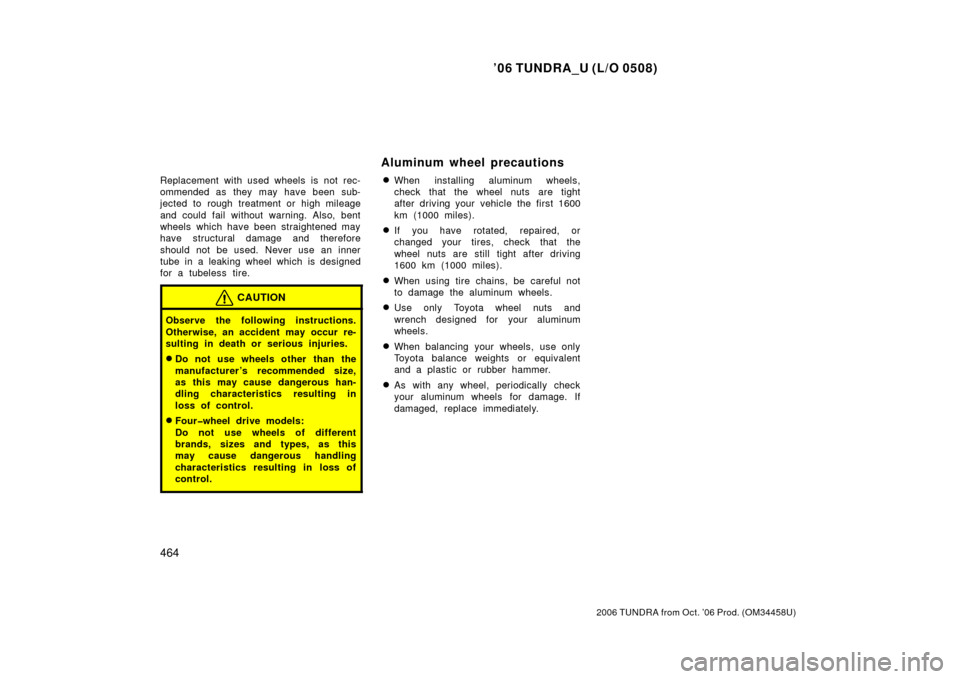Page 476 of 527

’06 TUNDRA_U (L/O 0508)
464
2006 TUNDRA from Oct. ’06 Prod. (OM 34458U)
Replacement with used wheels is not rec-
ommended as they may have been sub-
jected to rough treatment or high mileage
and could fail without warning. Also, bent
wheels which have been straightened may
have structural damage and therefore
should not be used. Never use an inner
tube in a leaking wheel which is designed
for a tubeless tire.
CAUTION
Observe the following instructions.
Otherwise, an accident may occur re-
sulting in death or serious injuries.
�Do not use wheels other than the
manufacturer ’s recommended size,
as this may cause dangerous han-
dling characteristics resulting in
loss of control.
�Four�wheel drive models:
Do not use wheels of different
brands, sizes and types, as this
may cause dangerous handling
characteristics resulting in loss of
control.
�When installing aluminum wheels,
check that the wheel nuts are tight
after driving your vehicle the first 1600
km (1000 miles).
�If you have rotated, repaired, or
changed your tires, check that the
wheel nuts are still tight after driving
1600 km (1000 miles).
�When using tire chains, be careful not
to damage the aluminum wheels.
�Use only Toyota wheel nuts and
wrench designed for your aluminum
wheels.
�When balancing your wheels, use only
Toyota balance weights or equivalent
and a plastic or rubber hammer.
�As with any wheel, periodically check
your aluminum wheels for damage. If
damaged, replace immediately.
Aluminum wheel precautions
Page 481 of 527

’06 TUNDRA_U (L/O 0508)
469
2006 TUNDRA from Oct. ’06 Prod. (OM 34458U)
Standard and access cab models
Double cab models
If the headlights or other electrical
components do not work, check the
fuses. If any of the fuses are blown,
they must be replaced.
See “Fuse locations” in Section 7 −1 for
locations of the fuses.
Turn the ignition switch and inoperative
component off. Pull the suspected fuse
straight out and check it.
Determine which fuse may be causing the
problem. The lid of the fuse box shows
the name of the circuit for each fuse. See
Section 8 for the functions controlled by
each circuit.
Type D—When any of the fuses are
blown, contact your Toyota dealer.
Type A fuses can be pulled out by the
pull −out tool. The location of the pull −out
tool is shown in the illustration.
If you are not sure whether the fuse has
blown, try replacing the suspected fuse
with one that you know is good.
If the fuse has blown, push a new fuse
into the clip.
Only install a fuse with the amperage rat-
ing designated on the fuse box lid. If you do not have a spare fuse, in an
emergency you can pull out the “DOME”
or “A/C” fuse, which may be dispensable
for normal driving, and use it if its amper-
age rating is the same.
If you cannot use one of the same amper-
age, use one that is lower, but as close
to the rating as possible. If the amperage
is lower than that specified, the fuse
might blow out again but this does not
indicate anything wrong. Be sure to get
the correct fuse as soon as possible and
return the substitute to its original clip.
It is a good idea to purchase a set of
spare fuses and keep them in your ve-
hicle for emergencies.
If the new fuse immediately blows out,
there is a problem with the electrical sys-
tem. Have your Toyota dealer correct it as
soon as possible.
CAUTION
Never use a fuse with a higher am-
perage rating, or any other object, in
place of a fuse. This may cause ex-
tensive damage and possibly a fire.
Page 486 of 527
’06 TUNDRA_U (L/O 0508)
474
2006 TUNDRA from Oct. ’06 Prod. (OM 34458U)
Removing clip
Installing clip
Use a Phillips�head screwdriver. Remove
and install the clip as shown in the fol-
lowing illustrations.
—Front turn signal/front side
marker lights
(double cab models)
Page 487 of 527
’06 TUNDRA_U (L/O 0508)
475
2006 TUNDRA from Oct. ’06 Prod. (OM 34458U)
Removing clip
Installing clip
Remove the bolts.
—Rear turn signal,
stop/tail/rear side marker and
back�up lights (type A)
Page 490 of 527
’06 TUNDRA_U (L/O 0508)
478
2006 TUNDRA from Oct. ’06 Prod. (OM 34458U)
a: Back�up light
b: Rear turn signal light
c: Stop/tail/rear side marker light
Remove the bulb of the back −up light at
first when removing that of the rear turn
signal light.
Use a Phillips�head screwdriver.
—License plate lights
Page 495 of 527
’06 TUNDRA_U (L/O 0508)
483
2006 TUNDRA from Oct. ’06 Prod. (OM 34458U)
kg (lb.)
Cab type
EngineDriving systemTransmission typeDeck typeGrade∗ 4Vehicle capacity
weight∗5, 6
Standard cab
models
4. 0 L V6
(1GR −FE)Tw o −wheel
driveManual transmissionStandard
bedStandard650 (1435)
Automatic transmissionStandard
bedStandard637 (1405)
4. 7 L V8
(2UZ −FE)
Tw o −wheel
driveAutomatic transmissionStandard
bedStandard
853 (1882)
832 (1836)∗ 1
909 (2005)∗3
Four −wheel
driveAutomatic transmissionStandard
bedStandard728 (1607)
708 (1561)∗ 1
Access cab
models
4. 0 L V6
(1GR −FE)Tw o −wheel
driveManual transmissionStandard
bedSR5630 (1391)
Automatic transmissionStandard
bedSR5608 (1342)
4. 7 L V8
(2UZ −FE)Tw o −wheel
driveAutomatic transmission
Standard
bedSR5734 (1620)
713 (1574)∗ 1
Limited781 (1722)
760 (1676)∗1
StepSide
bedSR5597 (1318)
576 (1272)∗1
Limited645 (1422)
624 (1376)∗1
Vehicle capacity weight
Page 496 of 527
’06 TUNDRA_U (L/O 0508)
484
2006 TUNDRA from Oct. ’06 Prod. (OM 34458U)
kg (lb.)
Cab type
EngineDriving systemTransmission typeDeck typeGrade∗4Vehicle capacity
weight∗ 5, 6
Access cab
models4. 7 L V8
(2UZ −FE)Four −wheel
drive
Automatic transmissionStandard
bedSR5614 (1355)
593 (1309)∗ 1
Limited669 (1477)
649 (1431)∗1
Automatic transmissionStepSide
bedSR5486 (1073)
465 (1027)∗1
Limited533 (1177)
513 (1131)∗1
Double cab
models4. 7 L V8
(2UZ −FE)
Tw o −wheel
drive
Automatic transmissionStandard
bedSR5
772 (1702)
753 (1661)∗ 1or2
734 (1620)∗1, 2
Automatic transmissionStandard
bedLimited
761 (1678)
742 (1637)∗1or2
723 (1596)∗1, 2
Four −wheel
drive
Automatic transmissionStandard
bedSR5
663 (1462)
644 (1421)∗ 1or2
625 (1380)∗1, 2
Automatic transmissionStandard
bedLimited
652 (1438)
633 (1397)∗1or2
615 (1356)∗1, 2
Page 498 of 527

’06 TUNDRA_U (L/O 0508)
486
2006 TUNDRA from Oct. ’06 Prod. (OM 34458U)
Cab typeEngineDriving systemWith or without towing packagekg (lb.)
Standard cab
models
4. 0 L V6
(1GR−FE) engineTw o −wheel drive modelsWithout towing package2358 (5200)
4. 7 L V8
(2UZ −FE) engine
Tw o −wheel drive modelsWithout towing package2494 (5500)
With towing package3311 (7300)
Four −wheel drive modelsWithout towing package2494 (5500)
With towing package3311 (7300)
Access cab
models
4. 0 L V6
(1GR −FE) engineTw o −wheel drive modelsWithout towing package2268 (5000)
4. 7 L V8
(2UZ −FE) engine
Tw o −wheel drive modelsWithout towing package2494 (5500)
With towing package3311 (7300)
Four −wheel drive modelsWithout towing package2358 (5200)
With towing package3175 (7000)
Double cab
models4. 7 L V8
(2UZ −FE) engine
Tw o −wheel drive modelsWithout towing package2358 (5200)
With towing package3175 (7000)
Four −wheel drive modelsWithout towing package2222 (4900)
With towing package3039 (6700)
∗: Trailer weight + car go weight
Towing capacity∗